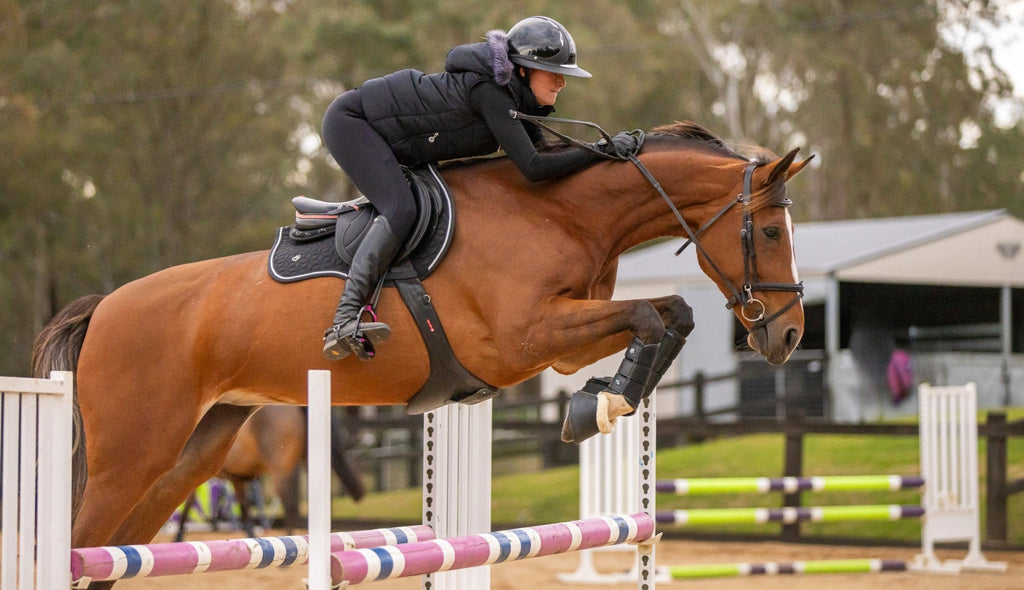Rider-Tested, Ambassador-Approved: Exercises to Elevate Your Training

Every horse and rider combination thrives on variety, and some exercises are just timeless for building balance, strength, and focus. Our ambassadors shared their favourites, and the common theme? Simple, consistent training that delivers big results.
Here are their go-to exercises, plus tips on how you can try them yourself.
Serpentines, Loops & Circles
With her strong show and dressage background, Amanda Gray loves serpentines, loops, and transitions to help her young horse develop balance, bend, and strength. She explains that keeping things fun and varied makes even the basics rewarding.
Try it: Ride three-loop serpentines in trot, asking for a smooth transition at each loop. Keep rhythm steady and the bend consistent. Add walk–trot or trot–canter transitions before picking up the new bend to sharpen your horse’s focus.
Long Reining Basics
For Mikayla Van Kampen, long reining is essential when working with young ponies. “Teaching them to turn and have good brakes is by far the most important base before asking more,” she says. It’s a simple yet powerful way to lay foundations without overloading them under saddle.
Try it: In a safe arena, start with walk–halt–walk transitions, then progress to large circles and gentle turns. You can also make obstacles with ground poles or cones. Practice walking over poles, between two poles laid next to each other on the ground and bend through cones. Keep sessions short and rewarding to build confidence.

Polework & Cavalletti
Poles are a clear favourite among our ambassadors. Christine Bates sets “four poles on a circle” to focus on rhythm, balance, and adjustability. Olivia Curtain loves cavalletti for straightness and precision, saying “there are so many different ways you can set them up to work on all sorts of things.” For Makenzie Patterson Hollibone, raised pole sessions are her go-to for sharpening her eye to bigger fences and improving course decision-making.
Try it: Start with a line of five trot poles, raising alternate ends to challenge balance. Then, try four poles set every quarter on a 20m circle (think of a clock face and place one at 12, 3, 6, and 9) to develop bend, or lay out cavalletti in a fan shape on a bend or cicle to encourage stride adjustability. You can ride this at the wider or tighter end of the fan.

Transitions for Balance & Responsiveness
Transitions are the foundation of responsiveness and engagement. Amelia Petrie’s favourite is walk-to-canter, combined with leg yields for suppleness. Nina Boyd enjoys refining simple transitions like trot–walk–trot and trot–canter–trot, and also rides without stirrups to improve her balance. “Strengthening these foundational skills lays the groundwork for mastering higher-level movements,” she explains.
Try it: Practice crisp trot–walk–trot transitions every few strides. Progress to trot–canter–trot, focusing on maintaining forward energy. Add leg yields from quarter line to track to encourage crossing over and suppleness.

Half Halts & Collected Work
Several ambassadors swear by the half halt. Lucy Taylor says she rides “a million of them at home to build strength, balance, and create more impulsion,” while Emma Adams focuses on half halts, collected work, and lateral exercises to develop suppleness and engagement.
Try it: In trot, ride a half halt before each corner to rebalance. Mix in shoulder-in or travers down the long side to reinforce connection and control.

Lateral Work for Suppleness
Lateral work helps keep horses supple, connected, and focused. Annabel Shoobridge uses exercises like leg yields and shoulder-in to ensure her horses stay tuned in. Amelia Petrie also incorporates leg yields into her routine for straightness and responsiveness.
Try it: Start with simple leg yields from quarter line to track. Once consistent, progress to shoulder-in, maintaining three clear tracks and steady rhythm. Progress by leg yielding to the wall then just before the short end of the arena, keep in a shoulder fore position, ride the corner, then ask for a deeper bend and more movement of the shoulder to ask for a few strides of shoulder in.
Stretching to Start & Finish
Sienna Mullan-Wright highlights the importance of stretching at the start and end of each session. “It’s such a good way to start and end our training,” she says, ensuring muscles are warmed up and cooled down properly.
Try it: Encourage your horse to take the bit forward and down in trot, maintaining rhythm and relaxation. Use this both as a warm-up and a cool-down to support muscle elasticity. When practicing stretch at a walk, encourage the horse to open the gullet to stretch and not just lower the neck.
Balance Work & Bareback Riding
For Ellie Roots, nothing improves rider feel and balance quite like sitting trot and bareback sessions. Stripping things back improves your seat and connection, while also allowing the horse to move freely.
Try it: Begin with walk and slow trot bareback, keeping posture tall and relaxed. Gradually build to longer trot stretches, always prioritising balance and softness.
The Takeaway
From serpentines to pole grids, half halts to bareback riding, these ambassador-approved exercises show that training progress doesn’t need to be complicated. The key is variety, consistency, and listening to your horse. Why not try one of these favourites in your next ride and see how it elevates your training?
SHARE:
